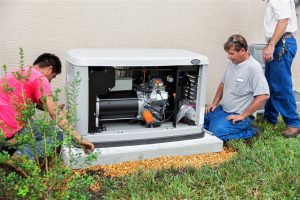 So, you’ve finally grown tired of fumbling around in the dark two or three times a year when the power goes out for an extended period of time. You’ve decided to install a generator in your home, but you haven’t the slightest idea what kind would fit your particular needs best.
So, you’ve finally grown tired of fumbling around in the dark two or three times a year when the power goes out for an extended period of time. You’ve decided to install a generator in your home, but you haven’t the slightest idea what kind would fit your particular needs best.
Well, fortunately for you, you don’t have to make the decision entirely on your own. Let’s have a look at the defining qualities of a couple of different generator times, and the ideal situation each is suited for.
Backup Generators
A backup generator is the most common type of generator in use across the country. Backup generators are also often referred to as “portable” generators, after their primary trait. These generators are powered by gasoline or propane, typically, and need to be refueled on a fairly regular basis. During a power outage, these generators need to be set up and restarted manually. Once started, the generator will supply power to any appliance connected to it. The generator most likely won’t be able to power the entire home. If you only need to keep a couple of things running until the power comes back on, though, a portable generator might be the perfect solution for you.
Automatic Standby Generators
For homeowners whose needs are a bit greater than a backup generator can provide, there is the automatic standby generator. Standby generators are not portable. Indeed, they have to be wired directly into a home’s electrical system in order to function. They’re typically installed outside the house, rather than being stored inside (both because they’re too large and because they need a way to vent exhaust). Standby generators also need to have their own continuous access to fuel. Oftentimes, they’re powered by a natural gas line either spliced into the preexisting one in the home, or a brand new one running directly to the city main.
All these added requirements are so the standby generator can do what it does best: operate without input. Standby generators contain something called an automatic transfer switch. This switch monitors the flow of electricity through the home at all times. When the power is suddenly cut off, the switch will activate the generator and switch the home over to use its power output. The generator receives its own fuel, so it doesn’t need you to go out and refuel it every couple of hours. It monitors when to turn on and off, so you don’t need to go outside to start or stop it. Finally, it provides more than enough power to keep the entire home operating for as long as necessary. If you have power-hungry systems that need to keep operating at all times, or if you just would prefer to have your entire home powered during an outage, an automatic standby generator sounds like a good idea.
When you’re ready for a professional generator installation, contact Sunset Air for an appointment. The next time the power goes out in your area, we’ll make sure that you’re ready for it.




